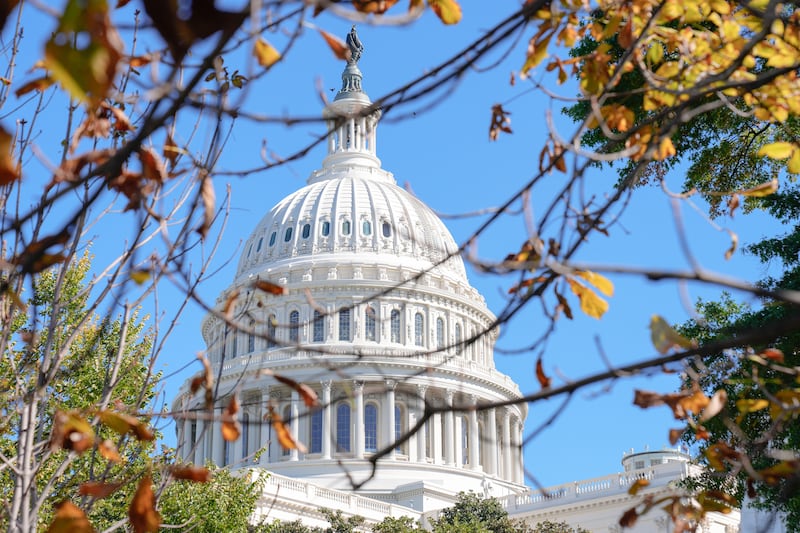Don’t look now, but the national debt just blew past $38 trillion in what the Associated Press is calling “the fastest accumulation of a trillion dollars in debt outside of the COVID-19 pandemic.”
The actual debt held by public investors is about $30.4 trillion. The rest is in intergovernmental holdings.
But that’s getting into the weeds, which may be why so much of the public seems to be caught in a perpetual yawn.
Perhaps you have lost interest because we passed $37 trillion only in August. Debt milestones are falling faster than walls at the White House these days.
Or maybe you’re not noticing because you’re too busy also not noticing that the government is shut down.
Public ignores the shutdown
David A. Graham of The Atlantic was keeping score last week. On Thursday, he noted the shutdown didn’t make the front page of the New York Times, it earned precisely one sentence on the front page of the Wall Street Journal and made the front page of The Washington Post only “tangentially in a story about Obamacare…”
Those two stories — the debt and the shutdown — are perhaps only tangentially related as well, other than in one way. Politicians’ fixation on whether to extend subsidies on the Affordable Care Act — supposedly the main reason for the shutdown — demonstrates perfectly how Washington is straining at gnats while real monsters lurk behind each corner.
How long will it take before the interest payments on all that debt (projected at $1 trillion this year) make all those public investors jittery? No one knows, but if the nation keeps adding $1 trillion every two months, we may soon find out.
That ought to be the real focus.
‘We can’t afford it’
During a recent campaign season, one candidate who visited our Deseret News/KSL editorial board made an impression on me by answering every question about a program by saying, curtly, “We can’t afford it.”
I don’t remember specifically which race she was in (we visited with so many candidates). She lost, but her four-word answer has stuck with me as perhaps the most sensible thing we heard that year.
But back to the shutdown: If Democrats win and secure an extension of health care subsidies that were put in place as a temporary measure during the pandemic it would add approximately $350 billion to the deficit over 10 years, according to the Congressional Budget Office.
But that has to be put in context.
As economist William McBride wrote for the Tax Foundation earlier this month, health care is already “by far the most heavily government-subsidized sector in the economy.”
“Healthcare spending has grown to almost one-third of the federal budget and, combined with tax preferences, now exceeds $2 trillion or 8% of GDP,” he wrote. “These subsidies are forecasted to continue growing faster than the overall economy, making reforms that control costs imperative to achieve a sustainable fiscal trajectory.”
Those who talk about protecting a free-market healthcare system must first explain how to establish one, and those few who talk about putting the nation’s deficit spending problem in order must talk about how to rein in healthcare spending.
It doesn’t help to shut down the government over subsidies that were meant to expire once the crisis of a pandemic had passed.
We can’t afford it.
Who is to blame?
The shutdown is likely to continue until one or the other political party feels the American electorate is overwhelmingly casting blame its way. A fresh poll for the Deseret News and the Hinckley Institute of Politics, conducted by Morning Consult, found that Utahns, at least, aren’t there yet. The poll found 42% blaming congressional Democrats, while 34% blame congressional Republicans, with 24% saying they don’t know. Only 12% of Democrats and 16% of Republicans blamed their own party.
But then, only 17% said they had personally experienced economic hardships because of the shutdown, and only 28% said they knew someone who had experienced this.
The shutdown isn’t top of mind for many people. Neither, most likely, is the national debt, which is so large it seems like an abstract concept.
But if you want a simplification, the Peter G. Peterson Foundation, an organization it says exists “to put America on a sustainable fiscal path,” offers this: “There are three primary drivers of the overall growth in spending: America’s aging population, rising healthcare costs, and rapidly escalating interest costs.”
Then it adds, “Significant growth in those categories is combined with a tax system that is not designed to collect enough revenues to fund the promises that have been made.”
Or, to put it in even simpler terms, we can’t afford it.
This, not shutting down the government over healthcare subsidies, ought to be the main focus in Washington.


